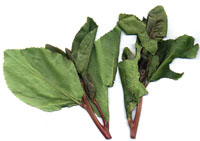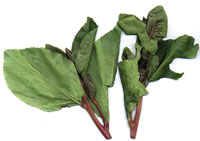
Qat: Catha Edulis As Anti-Microbial Activity [Archives:2000/46/Culture]
November 13 2000
Dr. Fareed Mohammed Saeed,

Ph. D. ENT Specialist
Sanaa General Police Hospital
Catha edulis is widely cultivated in the south of the Arabian Peninsula and south-eastern Africa (Korr, 1983). It plays an important role in the life of Yemeni society. People use it to cure such diseases as bronchial asthma, diarrhea, etc.
Quite many works have been devoted to studies on pharmacological properties of catha edulis. Most of them concentrated on the alkaloids present in this plant, and on the psychological effects of its application. However, there is evidence that the influence of catha edulis on the organism is not restricted by only amphetamine-like, CNS-stimulating effect. For example, the investigations by E. Jrgensen and T. kaimany (1990) have shown catha edulis to have pronounced anti-inflammatory effect. Kaimany and Jorgensen have proved through experiments, that qat has a sterilizing effect inside the mouth. The study by Tariq, Parmar et al (1984) has demonstrated the anti-ulcerous action of this plant. For the above reasons, we studied the microbial effects of two of the most widespread organisms, which cause ENT and other diseases.
Staphylococcus aureus
These organisms are spread in the air, dust, clothes, and bedding. They are transmitted to these places by infected people. They may also be founded as commensals in the nasal mucosa and throats of about 50% of healthy adults. They are also found in the adenoids of 20% and the skins of 10% of the people. These organisms generate rapidly especially in the nose and on the perineal skin. This type of organisms colonize the nasal cavities of about 9% of the newly born within the first two weeks after birth.
So these organisms infect the skin and its appendages such as the pustules, furuncles, boils, impetigo, styes, and also infect most wounds caused by surgeries or accidents. Pus in subcutaneous abscesses and connective tissues is also usually caused by these organisms. Other diseases caused by them also include generalized septicemia, intestinal disorders, staphylococcal food poisoning, and enteritis. The latter can be caused in rare cases by derangement of the intestinal floral due to treatment with some antibiotics. In some abnormal conditions, staphylococcus can cause severe inflammation in the intestines. Then it will have to be treated with an antibiotic to which the offending strain is sensitive.
Streptococcus pyogens (beta-haemolitic streptococci)
A healthy person may carry in his throat or nose several strains of streptococcus pyogens. Acute sore throat is commonly caused by such organisms. Cervical lymphadenitis is also caused by these organisms. The infection can spread to the middle ear, the mastoids, and even to the meninges. Scarlet fever results from the infection of the throat with streptococcus pyogens, which produces a toxin causing erythgenic. If the patient has no immunity against this toxin, the skin rash which characterizes the scarlet fever appears. Other diseases caused by streptococcus pyogens include impetigo, erysipelas, and post natal uterus infections such as puerperal sepsis. Their spread in the lymphatic system causes lymphangitis, lymphadenitis. They cause septicemia when they go into the blood stream. Streptococcus pyogens are also responsible for acute rheumatism and glomerulonephritis. Such diseases are preceded by a 2 or 3 week infection of the throat.
Evaluation of the Antimicrobial Activity
In Vitro
The antimicrobial activity to extract from catha edulis leaves was evaluated by its action on the cultures of staphylococcus aureus, streptococcus hemolyticus (two cultures). All microorganisms were obtained from patients with diseases of the upper respiratory tracts. They showed signs of increased pathogenic activity. The antimicrobial activity of catha edulis extract was studied for the dilutions of 1:10, 1:100, 1:300, 1:1000, and 1:3000. After 4 hours of cultivation, the concentration of staphylococcus activity in dilutions 91:10 – 1:1000) has reduced 4 times, on the average. In a day, the extract from catha edulis in all these dilutions was sterile. The dilution of 1:3000 did not cause complete bacterial effect. Streptococcus turned out to be more sensitive to the action of catha edulis extract suppressing action of the extract in 1:100 and 1:300 dilutions, on the streptococcus culture was noted right upon adding the microorganisms suspension. In 4 hours of cultivation, the extract in these dilutions, as well as in the 1:1000 one was practically sterile. In all the check experiments when physiological salt solution of NaCl was used instead of catha edulis extract (7 tests), 4 4.7 time increase in microorganisms concentration of staphylococcus and streptococcus was recorded in 4 hours. In a day, the growth of microorganisms was observed to be beyond all calculations. (See picture)
In Vivo
The experimentally revealed pharmacological properties of the preparation from catha edulis leaves make it possible to attribute it to the class of adaptogens-immune-modulators. It possesses antimicrobial and antiviral activity. The preparation is considered to be a promising one for the in clinical practice.
All in all, 50 patients with vasomotor rhinitis were treated. The essence of treating was in lavage of rhinopharynx and nasal cavity with the extract from catha edulis leaves in the concentration (1:300). Treatment lasts from 10 to 14 days. Efficiency of treatment was determined by observing the direct clinical effect (complete removal of the disease symptoms).
Bacterial sensitization has noticeably decreased after treating patients with the extract from catha edulis.The number of patients with sensitization to streptococcus and staphylococcus allergens has reduced more than 4 times as compared to the number before the treatment (p<0.01).
The clinical and laboratory investigations have shown catha edulis extracts to manifest antimicrobial action not only in vitro but also in vivo. Thus, a considerable reduction of general bacterial dissemination has been noted after the treatment. If compared to the index prior to the treatment, the number of patients with an increased bacterial dissemination has reduced 5 times after the therapy (p<0.01).
The above changes in the nasal autofloral of patients with vasomotor rhinitis after the treatment with the extract from catha edulis leaves testifies to the antimicrobial action of this preparation in vivo.
——
[archive-e:46-v:2000-y:2000-d:2000-11-13-p:./2000/iss46/culture.htm]


